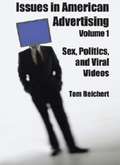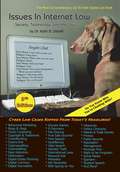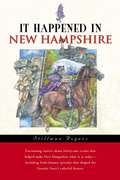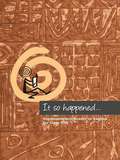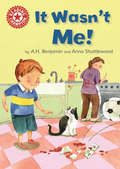- Table View
- List View
Issues and Life Science: Ecology, Revised
by Lawrence Hall of Science University of California BerkeleyNIMAC-sourced textbook <p>What kinds of future space missions should we fund and conduct? Students take observations from their everyday life and build scientific models to try to understand how phenomena, such as changes in the moon’s appearance, seasons, and gravity work. Through data collection and analyzation students later use their understanding of what can be learned through space missions to determine the trade-offs of different proposed space missions. PE Assessment Example: Prepare a labeled diagram that includes a caption explaining how Earth’s tilt and its orbit around the Sun cause each of the following: a. changes in the angle of sunlight hitting the Earth’s surface. b. the seasons in the Southern Hemisphere to be opposite of the seasons in the Northern Hemisphere. Solar System and Beyond is part of Issues and Science three year middle school program, designed by SEPUP at the Lawrence Hall of Science. This five week unit anchors the lessons around the the socio-science issue: What kind of future space missions should we fund and conduct? Investigative phenomena within the 17 activities connect back to the issue and storyline. This unit builds towards and assesses PEs ESS1-1, ESS1-2, ESS1-3. The Student Book guides students in exploring a socio-science issue and connected phemonena through a series of varied activity types. Activity types use one of twelve different instructional strategies to apply Science and Engineering Practices to specific Disciplinary Core Ideas and Cross Cutting Concepts. SEPUP's integrated literacy strategies help students process new science content, develop their analytical skills, make connections between related concepts, and express their knowledge orally and in writing. The built-in assessment system helps teachers identify students' strengths and weaknesses from the beginning of the unit. This allows them to adjust activities when needed so that all students get the best chance to build their knowledge and appreciation of science. At the back of the Student Book there is an Appendix containing additional resources for students, such as science skills, literacy strategies, and media literacy among others. </p>
Issues and Life Science: Evolution, Revised
by University of California at Berkeley Lawrence Hall of ScienceNIMAC-sourced textbook <p>How are people affected by and affecting evolution? Students explore Charles Darwin’s theory of evolution by natural selection, how populations of organisms change over time and how new species arise while others go extinct. They also learn to interpret the many sources of evidence for the evolution of life on Earth now and in the past. PE Assessment Example: Explain how environmental changes affect the sickle cell trait over time in your population. Use evidence, including mathematical representations, from your investigation to support your explanation. Evolution is part of Issues and Science three year middle school program, designed by SEPUP at the Lawrence Hall of Science. This seven week unit anchors the lessons around the the socio-science issue: How are people affected by and affecting evolution? Investigative phenomena within the 17 activities connect back to the issue and storyline. This unit builds towards and assesses PEs LS3-1, LS4-1, LS4-2, LS4-3, LS4-4, LS4-5, LS4-6. The Student Book guides students in exploring a socio-science issue and connected phemonena through a series of varied activity types. Activity types use one of twelve different instructional strategies to apply Science and Engineering Practices to specific Disciplinary Core Ideas and Cross Cutting Concepts. SEPUP's integrated literacy strategies help students process new science content, develop their analytical skills, make connections between related concepts, and express their knowledge orally and in writing. The built-in assessment system helps teachers identify students' strengths and weaknesses from the beginning of the unit. This allows them to adjust activities when needed so that all students get the best chance to build their knowledge and appreciation of science. At the back of the Student Book there is an Appendix containing additional resources for students, such as science skills, literacy strategies, and media literacy among others.</p>
Issues and Life Science: From Cells to Organisms, Revised
by Lawrence Hall of Science University of California BerkeleyNIMAC-sourced textbook <p>How should we prevent the spread of an infectious disease? Students investigate how scientists first learned about cells and how this discovery led to new understandings of how infectious diseases spread. They gather evidence about the structures and functions of cells, develop models of cells, and explain how cells in animals and plants get the matter and energy they need to survive and grow. PE Assessment Example: Based on what you have learned in the “Cells Alive!” activity and this activity, draw a diagram (or create another type of model) to show what happens to the food you eat. Your model should show the movement of matter and the release of energy stored in food. From Cells to Organisms is part of Issues and Science three year middle school program, designed by SEPUP at the Lawrence Hall of Science. This five to six week unit anchors the lessons around the the socio-science issue: How should we prevent the spread of an infectious disease? Investigative phenomena within the 15 activities connect back to the issue and storyline. This unit builds towards and assesses PEs LS1-1, LS1-2, LS1-6, LS1-7.</p>
Issues and Life Science: Reproduction, Revised
by University of California at Berkeley Lawrence Hall of ScienceNIMAC-sourced textbook <p>How do people use chemical reactions to solve problems? Students analyze and interpret data to determine whether chemical reactions have taken place. They use models to explain what takes place at the atomic/molecular scale during a reaction. They also apply what they learn about chemical reactions to such problems as designing useful products and identifying processes for cleaning up chemical wastes. PE Assessment Example: Use the reaction you have just studied to design, test, and modify a device that can be used as a handwarmer. Chemical Reactions is part of Issues and Science three year middle school program, designed by SEPUP at the Lawrence Hall of Science. This three week unit anchors the lessons around the the socio-science issue: How do people use chemical reactions to solve problems? Investigative phenomena within the 13 activities connect back to the issue and storyline. This unit builds towards and assesses PEs PS1-2, PS1-5, PS1-6. The Student Book guides students in exploring a socio-science issue and connected phemonena through a series of varied activity types. Activity types use one of twelve different instructional strategies to apply Science and Engineering Practices to specific Disciplinary Core Ideas and Cross Cutting Concepts. SEPUP's integrated literacy strategies help students process new science content, develop their analytical skills, make connections between related concepts, and express their knowledge orally and in writing. The built-in assessment system helps teachers identify students' strengths and weaknesses from the beginning of the unit. This allows them to adjust activities when needed so that all students get the best chance to build their knowledge and appreciation of science. At the back of the Student Book there is an Appendix containing additional resources for students, such as science skills, literacy strategies, and media literacy among others.</p>
Issues and Physical Science
by University of California at Berkeley Lawrence Hall of ScienceAs a different kind of science program, Issues and Physical Science uses several kinds of activities to teach science.
Issues and Physical Science (2nd Edition)
by University of CalIssues and Physical Science uses several kinds of activities to teach science. For example, you will observe and test the properties of elements and compounds. You will model the atoms and molecules that make up these substances. You will design and conduct investigations to explore energy transfer. You will investigate the motion of a cart on a ramp, and apply what you learn to the physics of automobile accidents and safety features. A combination of laboratories, investigations, readings, models, debates, role plays, and projects will help you uncover the nature of science and the relevance of physical science to your interests.
Issues and Physical Science: Chemical Reactions, Revised
by University of California at Berkeley Lawrence Hall of ScienceNIMAC-sourced textbook <p>How do people use chemical reactions to solve problems? Students analyze and interpret data to determine whether chemical reactions have taken place. They use models to explain what takes place at the atomic/molecular scale during a reaction. They also apply what they learn about chemical reactions to such problems as designing useful products and identifying processes for cleaning up chemical wastes. PE Assessment Example: Use the reaction you have just studied to design, test, and modify a device that can be used as a handwarmer. Chemical Reactions is part of Issues and Science three year middle school program, designed by SEPUP at the Lawrence Hall of Science. This three week unit anchors the lessons around the the socio-science issue: How do people use chemical reactions to solve problems? Investigative phenomena within the 13 activities connect back to the issue and storyline. This unit builds towards and assesses PEs PS1-2, PS1-5, PS1-6. The Student Book guides students in exploring a socio-science issue and connected phemonena through a series of varied activity types. Activity types use one of twelve different instructional strategies to apply Science and Engineering Practices to specific Disciplinary Core Ideas and Cross Cutting Concepts. SEPUP's integrated literacy strategies help students process new science content, develop their analytical skills, make connections between related concepts, and express their knowledge orally and in writing. The built-in assessment system helps teachers identify students' strengths and weaknesses from the beginning of the unit. This allows them to adjust activities when needed so that all students get the best chance to build their knowledge and appreciation of science. At the back of the Student Book there is an Appendix containing additional resources for students, such as science skills, literacy strategies, and media literacy among others.</p>
Issues and Physical Science: Chemistry of Materials, Revised
by University of California at Berkeley Lawrence Hall of ScienceNIMAC-sourced textbook <p>How do people use chemical reactions to solve problems? Students analyze and interpret data to determine whether chemical reactions have taken place. They use models to explain what takes place at the atomic/molecular scale during a reaction. They also apply what they learn about chemical reactions to such problems as designing useful products and identifying processes for cleaning up chemical wastes. PE Assessment Example: Use the reaction you have just studied to design, test, and modify a device that can be used as a handwarmer. Chemical Reactions is part of Issues and Science three year middle school program, designed by SEPUP at the Lawrence Hall of Science. This three week unit anchors the lessons around the the socio-science issue: How do people use chemical reactions to solve problems? Investigative phenomena within the 13 activities connect back to the issue and storyline. This unit builds towards and assesses PEs PS1-2, PS1-5, PS1-6. The Student Book guides students in exploring a socio-science issue and connected phemonena through a series of varied activity types. Activity types use one of twelve different instructional strategies to apply Science and Engineering Practices to specific Disciplinary Core Ideas and Cross Cutting Concepts. SEPUP's integrated literacy strategies help students process new science content, develop their analytical skills, make connections between related concepts, and express their knowledge orally and in writing. The built-in assessment system helps teachers identify students' strengths and weaknesses from the beginning of the unit. This allows them to adjust activities when needed so that all students get the best chance to build their knowledge and appreciation of science. At the back of the Student Book there is an Appendix containing additional resources for students, such as science skills, literacy strategies, and media literacy among others.</p>
Issues and Physical Science: Energy
by University of California at Berkeley Lawrence Hall of ScienceNIMAC-sourced textbook
Issues and Physical Science: Energy, Revised
by University of California at Berkeley Lawrence Hall of ScienceNIMAC-sourced textbook <p>How can people manipulate energy transfer and transformation to use energy more efficiently? Students learn about the transfer and transformation of energy in their everyday lives. They plan and carry out investigations and analyze and interpret data from experiments to investigate how energy is transferred and transformed. They also engage in engineering challenges to design and test devices to maximize and minimize energy transfer. PE Assessment Example: Design, test, evaluate, and redesign a solar oven that maximizes thermal energy transfer. Energy is part of Issues and Science three year middle school program, designed by SEPUP at the Lawrence Hall of Science. This six week unit anchors the lessons around the the socio-science issue: How can people manipulate energy transfer and transformation to use energy more efficiently? Investigative phenomena within the 15 activities connect back to the issue and storyline. This unit builds towards and assesses PEs PS3-3, PS3-4, PS3-5, MS-ETS1-4. The Student Book guides students in exploring a socio-science issue and connected phemonena through a series of varied activity types. Activity types use one of twelve different instructional strategies to apply Science and Engineering Practices to specific Disciplinary Core Ideas and Cross Cutting Concepts. SEPUP's integrated literacy strategies help students process new science content, develop their analytical skills, make connections between related concepts, and express their knowledge orally and in writing. The built-in assessment system helps teachers identify students' strengths and weaknesses from the beginning of the unit. This allows them to adjust activities when needed so that all students get the best chance to build their knowledge and appreciation of science. At the back of the Student Book there is an Appendix containing additional resources for students, such as science skills, literacy strategies, and media literacy among others.</p>
Issues and Physical Science: Fields and Interactions, Revised
by University of California at Berkeley Lawrence Hall of ScienceNIMAC-sourced textbook <p>Fields and Interactions is part of Issues and Science three year middle school program, designed by SEPUP at the Lawrence Hall of Science. This five week unit anchors the lessons around the the socio-science issue: How do different types of force fields help us design transportation? This unit builds towards and assesses PEs PS2-3, PS2-4, PS2-5, PS3-2, ETS1-1, ETS1-2. The Student Book guides students in exploring a socio-science issue and connected phemonena through a series of varied activity types. Activity types use one of twelve different instructional strategies to apply Science and Engineering Practices to specific Disciplinary Core Ideas and Cross Cutting Concepts. SEPUP's integrated literacy strategies help students process new science content, develop their analytical skills, make connections between related concepts, and express their knowledge orally and in writing. The built-in assessment system helps teachers identify students' strengths and weaknesses from the beginning of the unit. This allows them to adjust activities when needed so that all students get the best chance to build their knowledge and appreciation of science. At the back of the Student Book there is an Appendix containing additional resources for students, such as science skills, literacy strategies, and media literacy among others.</p>
Issues and Physical Science: Force and Motion
by University of California at Berkeley Lawrence Hall of ScienceNIMAC-sourced textbook
Issues and Physical Science: Force and Motion, Revised
by University of California at Berkeley Lawrence Hall of ScienceNIMAC-sourced textbook
Issues and Physical Science: Waves, Revised
by Lawrence Hall of Science University of California BerkeleyNIMAC-sourced textbook <p>How are waves both helpful and harmful? Students encounter a variety of technologies that make use of waves. They also investigate the harmful effects of certain waves and methods to mitigate the risks associated with these waves. PE Assessment Example: Use what you learned from your hands-on investigation to explain why noise is more of a problem for analog vs digital signals, and why digital signals are more reliable to encode and transmit information. Waves is part of Issues and Science three year middle school program, designed by SEPUP at the Lawrence Hall of Science. This five week unit anchors the lessons around the the socio-science issue: How are waves both helpful and harmful? Investigative phenomena within the 15 activities connect back to the issue and storyline. This unit builds towards and assesses PEs PS4-1, PS4-2, PS4-3. The Student Book guides students in exploring a socio-science issue and connected phemonena through a series of varied activity types. Activity types use one of twelve different instructional strategies to apply Science and Engineering Practices to specific Disciplinary Core Ideas and Cross Cutting Concepts. SEPUP's integrated literacy strategies help students process new science content, develop their analytical skills, make connections between related concepts, and express their knowledge orally and in writing. The built-in assessment system helps teachers identify students' strengths and weaknesses from the beginning of the unit. This allows them to adjust activities when needed so that all students get the best chance to build their knowledge and appreciation of science. At the back of the Student Book there is an Appendix containing additional resources for students, such as science skills, literacy strategies, and media literacy among others. </p>
Issues in American Advertising: Media, Society, and a Changing World
by Tom ReichertEssays on issues in American advertising.
Issues in Internet Law: Society, Technology, and the Law (Ninth Edition)
by Keith B. DarrellThis book provides a concise overview of Internet law updated with the latest cases and trends.
Issues, Evidence and You Student Book
by Lawrence Hall of Science SepupIssues, Evidence and You (IEY) uses several kinds of activities to teach science. For example, you will design and conduct an experiment to determine the amount of acid in simulated industrial waste water. You will investigate the chemical and physical properties of plastics and other common materials. And you will apply what you have learned about energy and materials to design an energy-efficient car.
It Happened in New Hampshire
by Barbara Radcliffe Rogers Stillman RogersIncludes the fall of the Old Man From its earliest settlements at Odiorne Point, Dover, and Portsmouth, New Hampshire was different from the other colonies. Its history holds many surprises and a number of events that were significant to the founding and growth of the United States. It Happened in New Hampshire reveals the fascinating stories behind thirty events that helped shape the state's history.
It So Happened - Supplementary Reader in English class 8 - NCERT
by Training National Council of Educational ResearchThe main objective of this supplementary reader is to promote among learners the habit of reading independently with interest, understanding and enjoyment. It seeks to enable them to read independently in the sense that they would not expect the book to be taken up page by page in the classroom. They would rather read it on their own and later share and confirm their responses and appreciation with the teacher and the peer group through discussions, questions and, wherever possible, even role-play. The book contains eleven pieces. Each piece has been divided into two or three manageable sections, each section briefly summarised in point form without revealing crucial turns and twists of the storyline, thus sustaining readers’ curiosity and interest. While-reading ‘Comprehension Check,’ given at the end of sections, is a recall of what has been read and understood so far. This format is being tried to make comprehension easier and concentration keener. Each piece is also followed by a set of questions as aids to understanding and, at many places, topics for discussion in groups. Points under ‘Think it Over’ are largely such quotations as have a direct bearing on the theme of the story. Some quotations may not be immediately comprehensible to learners. Teachers may therefore want to play a direct role in explaining, simplifying or paraphrasing lines/topics and suggest appropriate sub-topics to facilitate a focussed discussion in small groups. All questions should be attempted orally before well- formulated answers are put down on paper. Discussion on related topics should be encouraged so that learners get an opportunity to go beyond the book and feel inspired to reach hitherto undiscovered vistas of knowledge and pleasure. The stories, amply illustrated, deal with themes of cooperation, compassion, respect and love for flora and fauna, sound decision-making, science fiction, education, peace and harmony. It is hoped that young readers will find the book enjoyable and rewarding, and will feel motivated to read extensively on their own to become proficient readers in the years to come.
It So Happened: Supplementary Reader in English class 8 - NCERT - 23
by National Council of Educational Research and Training"It So Happened" is a supplementary reader in English designed for Class VIII students. The textbook is a collection of engaging stories that explore diverse themes, characters, and moral lessons. Through carefully selected narratives, the book aims to enhance students' reading comprehension skills, vocabulary, and critical thinking abilities. The stories are thought-provoking and cover a range of genres, providing students with a holistic literary experience. The characters and situations in the book offer valuable insights into human nature, ethical dilemmas, and the complexities of life. "It So Happened" not only serves as a tool for language development but also encourages students to reflect on universal values and principles embedded in the narratives.
It Wasn't Me!: Independent Reading Red 2 (Reading Champion #20)
by A.H. BenjaminWho knocked over Cat's dinner? Who splashed the washing with mud? Who spilled the water everywhere? It Wasn't Me!Reading Champion offers independent reading books for children to practise and reinforce their developing reading skills.Fantastic, original stories are accompanied by engaging artwork and a reading activity. Each book has been carefully graded so that it can be matched to a child's reading ability, encouraging reading for pleasure.Independent Reading Red 2 stories are perfect for children aged 4-5 who are reading at book band 2 (Red) in classroom reading lessons.In this story a young boy is mischievous with his football but blames the cat each time something gets broken!
It's About Time: Middle School Inquiry Project-Based Life Science
by Janet L. Kolodner Joseph S. Krajcik Daniel C. Edelson Brian J. Reiser Mary L. StarrScience textbook for middle school students.

